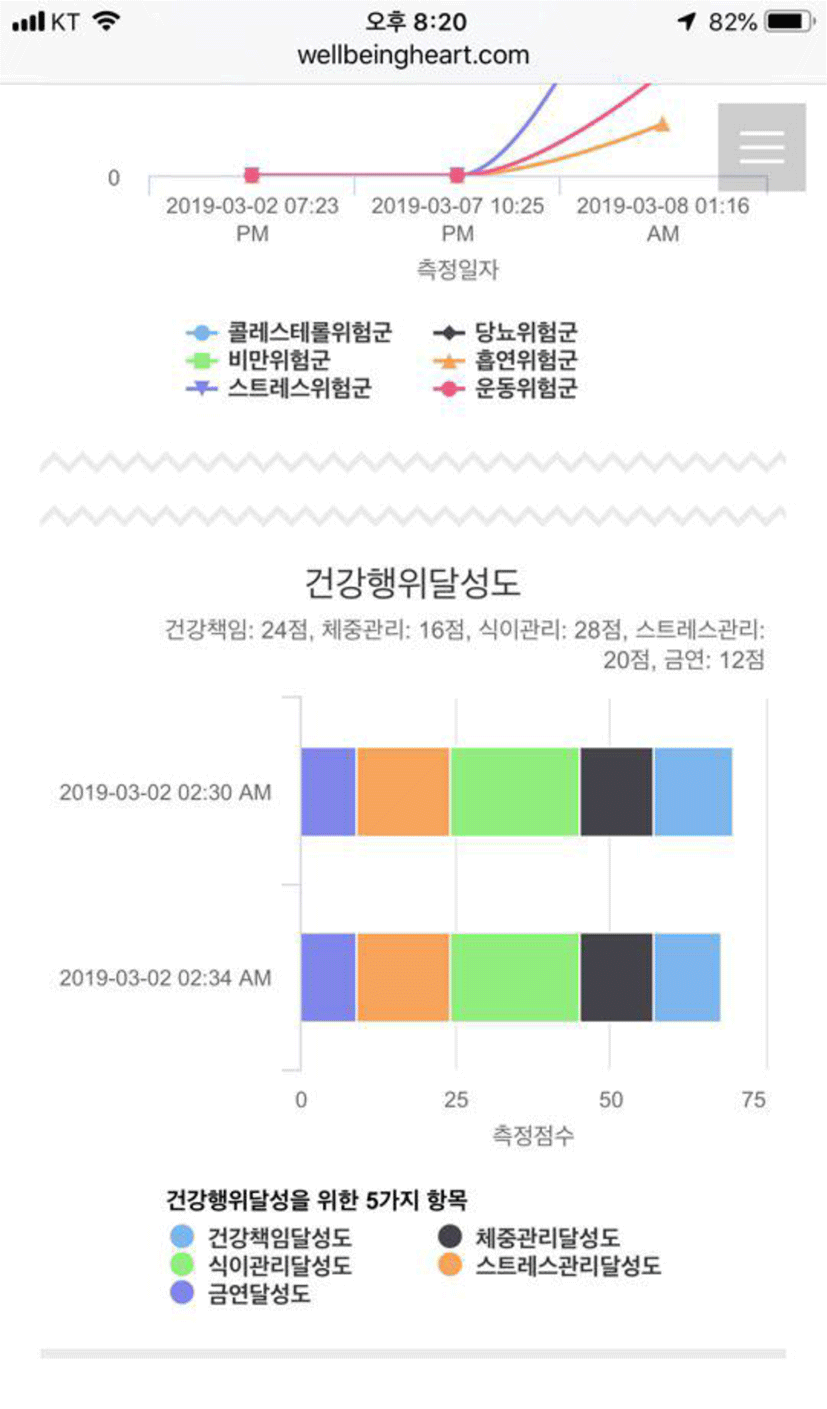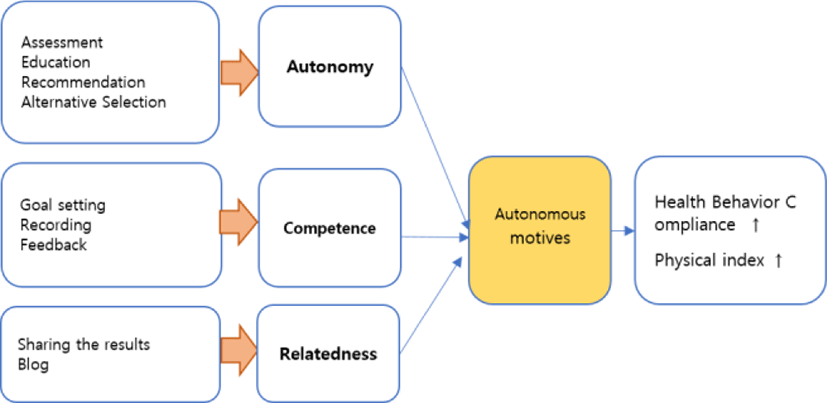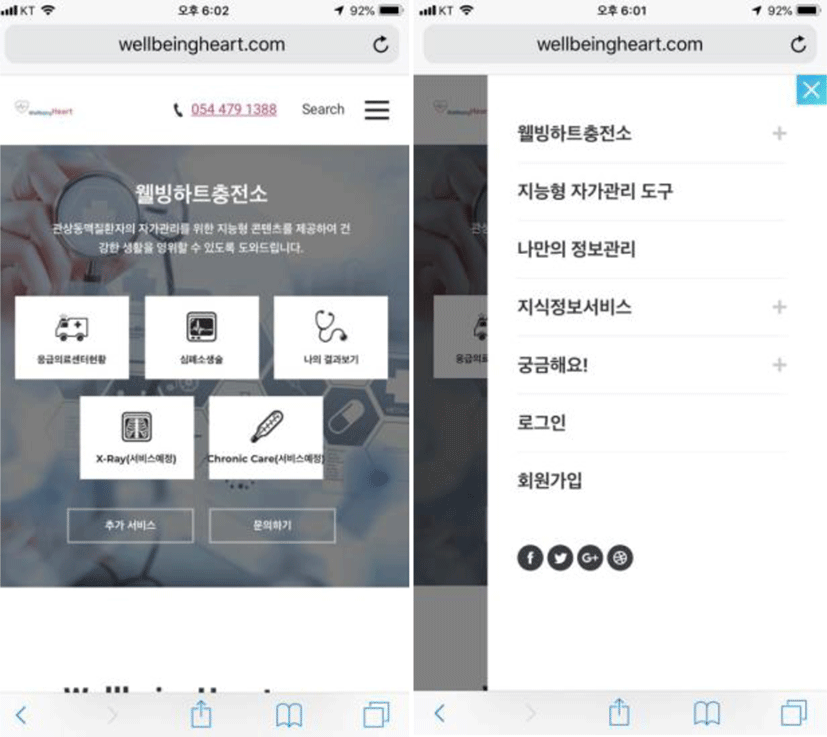I. INTRODUCTION
Coronary artery disease (CAD), which is a heart disease with a fatality rate exceeding 50%, is an ischemic disease where the coronary arteries, which maintain the function of the heart by supplying oxygen-rich blood and nutrition, become narrowed or blocked, resulting in impaired blood flow to the myocardium. CAD includes myocardial infarction, which causes myocardial necrosis, and angina, which causes chest pain due to a temporary anaerobic condition [1]. CAD is a chronic disease with acute pathogenesis and has a high risk of recurrence and sudden death. More specifically, myocardial infarction has a 20–30% fatality rate for the first occurrence; the recurrence rate after treatment is approximately 68–85%, which in turn causes a higher fatality rate [2]. In the U.S., it is reported that, within two years after initial treatment, the recurrence or preventative perfusion therapy rate is 42.2%, and the fatality rate is approximately 14.6% [3]. In South Korea, it is reported that, within one year after percutaneous coronary intervention, the recurrence or preventative reperfusion therapy rate is 14.6%, and the fatality rate is 4.5% [4]. Considering these values, fundamental measures for preventing recurrence are required in addition to the primary prevention measures for CAD.
Health behavior compliance was defined by Haynes and Sackett (1979) as the extent to which the patient’s behavior complies with the treatment plans and practices recommended by their health professionals [5]. In 2013, WHO defined health behavior compliance as the subject’s behaviors such as physical activity, dietary control, smoking cessation, and sobriety that effect lifestyle changes. CAD patients should maintain their recommended health behaviors such as quitting smoking, controlling weight, blood pressure and sugar level, good eating habits, and regular exercise [6]. Health behaviors through improved lifestyle can be managed most effectively when they are established as a long-term lifestyle. Furthermore, health behaviors should be simultaneously conducted through various health controls, such as weight control, exercise, smoking cessation, and medication compliance. Due to these reasons, it is reported that the health behaviors of CAD patients are not practiced well [7].
For continuous health behavior compliance by CAD patients once they have left the hospital, it is important to provide motivation to satisfy their basic psychological desires to encourage self-regulation for compliance with health behaviors, and further, encourage changes in lifestyle, which can be accomplished by developing and applying a self-management program constructed based on the self-determination theory. For this reason, in this study, a self-management application to support CAD patients based on the self-determination theory is developed. A heuristic evaluation and quality assessments by users are conducted to ensure that the application meets the needs of the users.
II. HEALTH BEHAVIOR COMPLIANCE
The American Heart Association claimed in 2009 that various factors such as age, sex, family history, smoking, hyperlipidemia, lack of exercise, obesity, diabetes, stress, drinking, and eating habits could affect CAD. If the patient is aware of these reversible risk factors and realizes the necessity and importance of lifestyle changes such as weight loss, dietary change, regular exercise, smoking cessation, and the regular taking of medication, then continuous good health behaviors can be achieved [8]. These types of health behavior compliance have positive effects on the recovery, avoidance of recurrence, and health maintenance of CAD patients [9]. Unfortunately, the awareness of these risk factors was found to be very low in the outpatients of the university hospitals receiving follow-up treatments after CAD [10]. Furthermore, patients with acute coronary syndrome who were hospitalized in the department of internal cardiovascular medicine were found to have a very understanding of their disease [11]. Also, according to a study conducted on the knowledge of patients with CAD, the awareness of risk factors and the benefits of diet, exercise, and rest were good, but detailed knowledge related to CAD itself and medication and lifestyle issues were misunderstood or incomplete [1]. Recognition of risk factors and a better understanding of their disease can improve their behavior by motivating lifestyle changes and thereby lowering risk factors, and, in turn, reducing recurrence and fatality rates. However, due to the current limited awareness of the risk factors and the knowledge of their disease, health behavior compliance is not well maintained. As a result, the fatality rate in patients with myocardial infarction is reported at 8.3% within one year of leaving the hospital, and for the case of percutaneous coronary intervention, recurrence or revascularization therapy is reported at 14.6% with a fatality rate of 4.5% [3]. Therefore, due to the nature of recurrences of a disease that has fatal consequences, it is important to undertake measures to prevent such recurrences. To reduce recurrence and cardiac deaths in patients suffering from CAD, the WHO (2013) emphasized the importance of post-discharge care and recommended health behavior compliance through actions such as disease prevention and management, medication to control risk factors, smoking cessation, dietary control, increase in physical exercises, exercise habits, blood pressure control, weight control, and regular check-ups to improve functional status and psychological well-being.
III. CONCEPTUAL FRAMEWORK OF THE STUDY FOR THE SELF-MANAGEMENT PROGRAM
This study was designed to develop a self-management program for patients with CAD and to evaluate the effectiveness of the application. A conceptual framework of the study was constructed based on the self-determination theory by Deci and Ryan (2002), as shown in Fig. 1 [12].
The constructive concepts of the health behavior compliance model for CAD patients are based on the self-determination theory that every patient has a basic psychological desire and self-deterministic motivation. Basic psychological desire consists of three components: autonomy, competence, and relatedness. Based on the satisfactory level of basic psychological desire, self-regulation, which is a dynamic internalized process of motivation, can be strengthened to promote healthy behavior and encourage motivation for self-determination.
In sum, coronary artery patients have basic psychological desires of autonomy, competence, and relationship, and by using a self-management program that supports their health behavior compliance, these three desires can be satisfied. In turn, self-regulation and the intrinsic motivation of the self-determination process are promoted. As a result, these internalized self-regulations improve self-efficacy to comply with health behaviors.
Table 1 shows the components and details that reflect the three basic psychological desires of the CAD self-management program.
IV. DEVELOPMENT OF SELF-MANAGEMENT PROGRAM FOR CAD
This research was approved by the Kyungpook National University Industry Foundation Board (IRB 2018-0154). Surveys were performed to provide preliminary research regarding the disease-related knowledge and educational needs of CAD patients. These surveys were conducted on 58 CAD patients who visited the Internal Medicine Department of C Hospital in G City, Gyeongsangbuk-do from December 2016 to March 2017, and the survey results were taken into account when developing the program [13].
Table 2 shows the six services the main menu of the program: (1)introduction of the well-being heart charging station, (2)intelligent self-management tool, (3)my information management, (4)view my results, (5) knowledge information service, (6) and automatic weekly summary reminder service. In addition to the above six main menus, the program consists of 20 submenus. The domain was named as wellbeingheart.com, and the program was developed as a hybrid application utilizing an application and the web to enable users to be able to perform self-management from any location.
Patients can use the intelligent self-management tool to immediately identify their risk factors and manage their risk factors at any time from the My Information and My Results menu. Additionally, warning notifications are given for the risk factors of the patient. Warning notifications are a way to allow patients to voluntarily manage their health. Patients can ask health professionals through live chats and they can create blogs among patients.
V. EVALUATION
Heuristic evaluation requires about three to five professionals, as proposed by Neilsen et al.. In this study, a total of 8 professionals were selected for the evaluation.

The evaluators were as follows: two medical professionals with more than five years of experience, two professionals from the computer engineering field, one professional from the medical informatics field, and three professionals from the nursing field. The heuristic evaluation tool used in this study is a tool modified and supplemented for chronic patients by Jae-hee Jeon [14]. This tool is based on the ten heuristic principles developed by Nielson, which was then revised by Bertini et al. to combine Nielsen’s Severity Ranking Scale (SRS) with eight mobile heuristic evaluation principles, which were supplemented for mobile use.
The heuristic evaluation used in this study includes the following eight principles: (1)visibility of system status, (2) match between system and the real world, (3)consistency and mapping, (4)good ergonomics and minimalist design, (5)ease of input, screen readability, and glanceability, (6) flexibility and efficiency, (7)aesthetics, and (8)error management. Each principle was evaluated based on the severity level on a five-point scale with a score of zero representing no issues with the principle and score closer to 4 representing the need for corrections.
As a result of heuristic evaluation, a score of 1, which means that a usability problem exists but does not necessarily require repair, was given by an evaluator in each of the following five principles: consistency and mapping, ergonomics and minimalist design, flexibility and efficiency, aesthetics, and error management. Two evaluators gave the ease of input, screen readability, and glanceability principle a score of 1. Our research team modified the program to reflect the minor opinions of a problem existing but not necessarily needing to be fixed.
The program was assessed by eight CAD patients using a quality evaluation tool based on the information systems success model [15], [16]. The program quality was measured using 24 questions based on a five-point scale. The questions were as follows: seven questions on system quality, six questions on information quality, five questions on service quality, three questions on user satisfaction, and three questions on program usage. The system quality category had the highest score with 4.6 out of 5, and the information quality had the lowest score with 3.87 out of 5. The overall average score was 4.08, which represented general satisfaction on the quality.
| Variable | Mean ± standard deviation |
|---|---|
| System Quality | 4.50±0.63 |
| Information Quality | 3.87±0.53 |
| Service Quality | 3.90±0.54 |
| Satisfaction | 4.33±0.57 |
| Actual Use | 3.83±0.61 |
| Total | 4.08±0.57 |
VI. FUTURE PLANS AND CONLUSION
The reason for receiving a score of one from two professionals on the ease of input, screen readability, and glanceability principle in the heuristic evaluation was due the order of the menu, but this issue has been handled and modified in the application. The assessment of the quality of the program evaluated by the patients was found to be generally satisfactory. If the quality assessment score is high score, it appears to have an Intention to use continuously.
We will continue to study that the factors in the quality assessment can continue to affect the intention to use by increasing the number of users. And, the developed self-management program for CAD patients is planned to be applied to actual patients for a total of 4 weeks, beginning in March 2020. During this period, the program will receive more specific evaluations from the users. For future work, a mobile app could be easy-to-use and very helpful for patients.













